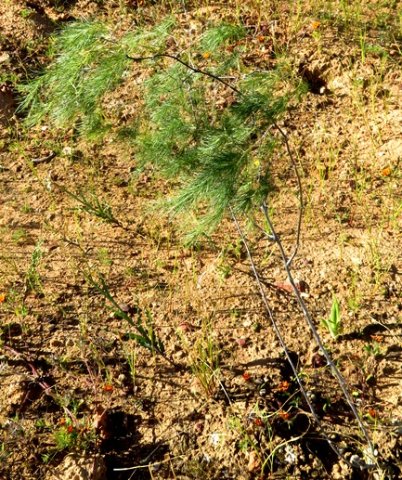Asparagus

Author: Ivan Lätti
Photographer: Thabo Maphisa
The Asparagaceae family comprising only one genus in southern Africa, Asparagus, used to be part of the Liliaceae family that has 15 genera and more than 700 species. The Amaryllidaceae including the Allium or onion genus and many other flowering plants, as well as the Asphodelaceae family in which one finds the aloes and more, were also earlier part of Liliaceae.
The family connection is, of course, still exactly the same, the increased differentiation only reflecting the growth in botanical knowledge. This living body of knowledge grows continually from newly discovered details and restructuring added by numerous human contributors.
There are about 120 Asparagus species in southern Africa, another 180 or so elsewhere on earth. The local ones were at one stage called Protasparagus, a name no longer upheld.
The most well-known Asparagus species on earth, the popular spring vegetable commonly known as sparrow grass or formally as Asparagus officinalis, is grown or consumed worldwide. It includes white asparagus, obtained from bleaching the shoots.
Asparagus plants are suffrutices or scramblers. The plant’s stem is periodically replaced by new “main” stems growing in successive seasons. The plants have many roots, fibrous or tuberous.
Real leaves are mostly absent or reduced and bract-like. The common cladodes or false leaves, often thought to be leaves, are persistent or deciduous upon the branched stems. In shape they are terete (narrowly cylindrical) and straight or angled, flat-bladed and ovate, leaf-like. The variable stems may be spiny or not.
Asparagus flowers have six tepals growing in two whorls. There are six stamens. The ovary is superior and three-locular, the stigma three-lobed or three-branched. The fruits are mostly ovoid or globose berries.
The plant in picture seen in Namaqualand has long thin cladodes growing in clusters. It may be A. nelsii, the sandveldkatbos (sand veld cat bush) occurring widespread inland in the Northern Cape, North West and Limpopo (Leistner, (Ed.), 2000; iNaturalist; http://redlist/sanbi.org).

